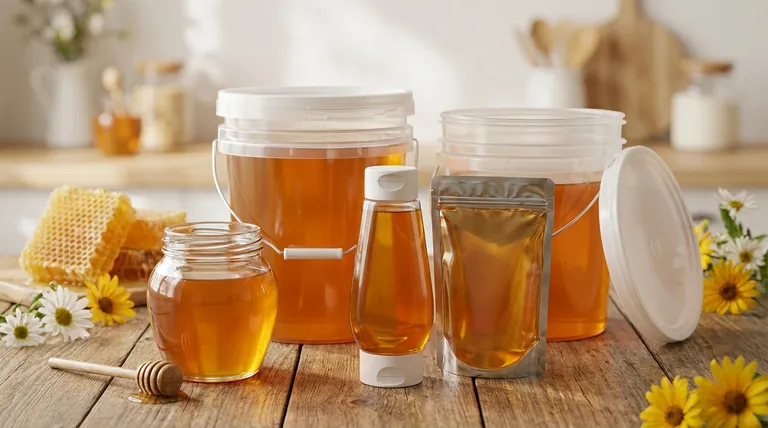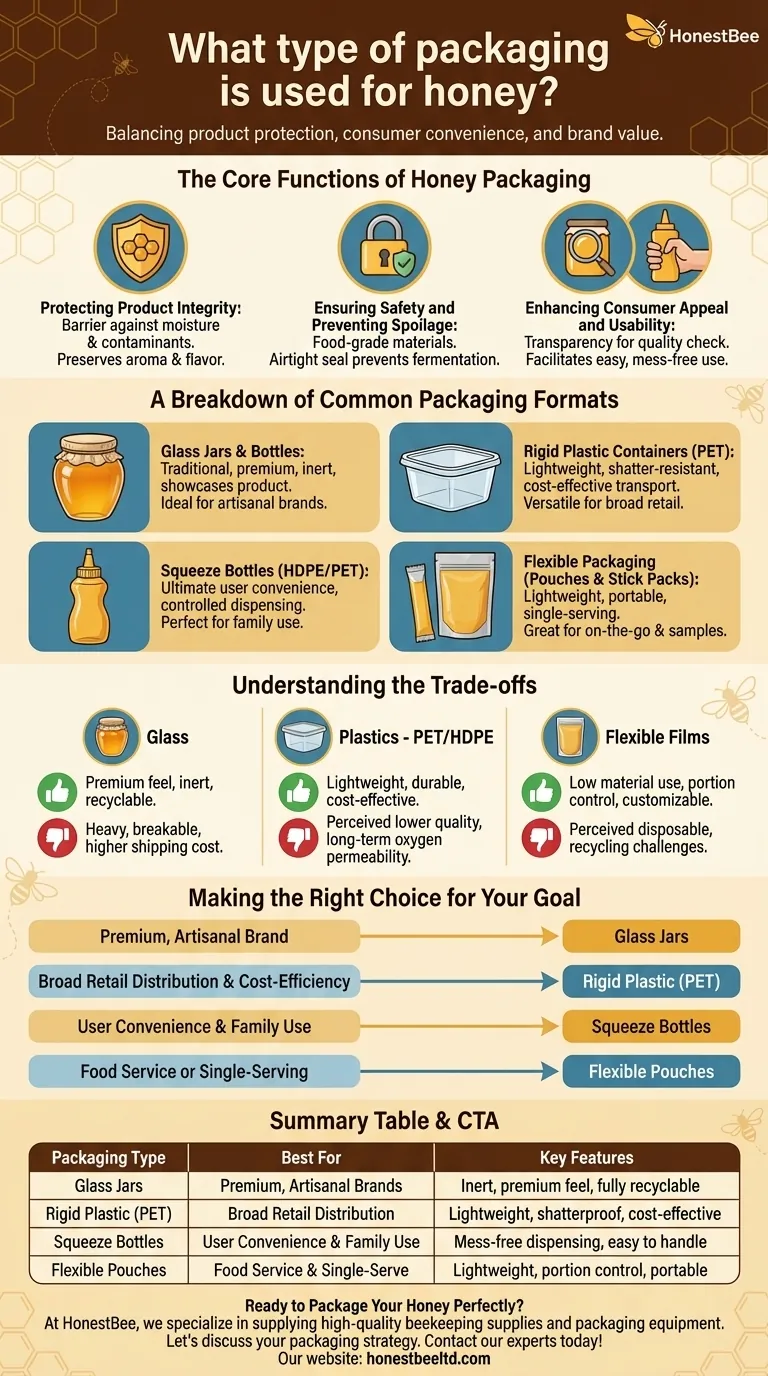Ultimately, honey is packaged in a variety of containers, with the most common being glass jars, rigid plastic containers (often PET), user-friendly plastic squeeze bottles, and flexible pouches or sachets. The choice of material—glass or specific plastics like Polyethylene Terephthalate (PET), High-density Polyethylene (HDPE), and Polypropylene (PP)—depends on factors like brand positioning, cost, and consumer use case.
The selection of honey packaging is not just about choosing a container; it's a strategic decision that balances product protection, consumer convenience, and the communication of brand value.

The Core Functions of Honey Packaging
Before examining the specific types of containers, it's crucial to understand what the packaging must accomplish. Good packaging is a functional necessity that safeguards the product from the producer to the consumer's pantry.
Protecting Product Integrity
Honey's quality can be degraded by environmental factors. A primary role of packaging is to create a barrier against moisture and airborne contaminants.
Proper sealing is essential to preserve honey's unique natural aroma and flavor, preventing it from absorbing other odors.
Ensuring Safety and Preventing Spoilage
The packaging must be made from food-grade materials that do not react with the honey. This ensures that no harmful chemicals leach into the product.
An airtight seal is critical to prevent fermentation and spoilage, extending the shelf life of the honey.
Enhancing Consumer Appeal and Usability
Transparency is a key feature, as most consumers want to see the color and clarity of the honey before buying.
The packaging also serves as the vehicle for the brand's identity through labeling and container shape, and it should facilitate easy use, such as mess-free dispensing.
A Breakdown of Common Packaging Formats
Each packaging format serves a different segment of the market, from premium artisanal products to convenient, single-serving options.
Glass Jars and Bottles
Glass is the traditional and premium choice for honey packaging. It is completely inert, meaning it won't affect the honey's taste.
Its transparency showcases the product beautifully, and its weight and feel convey a sense of high quality. Classic shapes like the "queenline" jar are iconic in the honey industry.
Rigid Plastic Containers
Containers made from PET plastic are the most common alternative to glass. They are lightweight, shatter-resistant, and highly transparent.
This makes them more cost-effective to transport and safer to handle than glass, making them a versatile choice for a wide range of brands.
Squeeze Bottles
A popular subset of plastic packaging, squeeze bottles (often made of HDPE or PET) are designed for ultimate user convenience.
They allow for controlled, mess-free dispensing, which is highly valued by consumers, especially in family households.
Flexible Packaging (Pouches & Stick Packs)
This modern format includes single-serving sachets, stick packs, and larger resealable pouches.
This type of packaging uses the least amount of material, is extremely lightweight, and is ideal for on-the-go consumption, food service applications, or product samples.
Understanding the Trade-offs
Choosing the right material involves weighing the benefits of product presentation, cost, and durability. There is no single "best" option; the ideal choice depends entirely on your specific goals.
Glass: The Premium Standard
- Pros: Excellent product protection, premium look and feel, infinitely recyclable, completely inert.
- Cons: Heavy, breakable, and has a higher shipping cost compared to plastic.
Plastics (PET & HDPE): The Versatile Workhorse
- Pros: Lightweight, highly durable, shatterproof, and cost-effective for transport.
- Cons: Can be perceived as lower quality than glass; potential for oxygen permeability over very long storage periods.
Flexible Films: The Modern Convenience
- Pros: Extremely low material usage and weight, excellent for portion control, highly customizable shapes and printing.
- Cons: Can be perceived as disposable or low-value; recycling can be more challenging for consumers than with rigid containers.
Making the Right Choice for Your Goal
Your packaging choice is a direct reflection of your brand strategy and target customer. Analyze your primary objective to select the most appropriate format.
- If your primary focus is a premium, artisanal brand: Glass jars are the established choice for showcasing high quality and tradition.
- If your primary focus is broad retail distribution and cost-efficiency: PET plastic containers offer the best balance of durability, weight, and cost.
- If your primary focus is user convenience and family use: Plastic squeeze bottles are unmatched for their easy, mess-free dispensing.
- If your primary focus is food service or single-serving products: Flexible pouches and stick packs provide ideal portion control and portability.
Ultimately, the best honey packaging aligns your product's integrity with your customer's needs and your brand's identity.
Summary Table:
| Packaging Type | Best For | Key Features |
|---|---|---|
| Glass Jars | Premium, Artisanal Brands | Inert, premium feel, fully recyclable |
| Rigid Plastic (PET) | Broad Retail Distribution | Lightweight, shatterproof, cost-effective |
| Squeeze Bottles | User Convenience & Family Use | Mess-free dispensing, easy to handle |
| Flexible Pouches | Food Service & Single-Serve | Lightweight, portion control, portable |
Ready to Package Your Honey Perfectly?
Choosing the right packaging is critical for protecting your honey and appealing to your customers. At HONESTBEE, we specialize in supplying high-quality beekeeping supplies and packaging equipment to commercial apiaries and distributors. We can help you source the ideal containers—from durable PET jars to convenient squeeze bottles—that align with your brand and operational needs.
Let's discuss your packaging strategy. Contact our experts today to get started!
Visual Guide

Related Products
- Food Grade Plastic Honey Bucket Pail for Beekeeping
- Inverted Squeezable Honey Jar with No Drip Flip Top Cap for Easy Pouring
- Premium Heat-Resistant Glass Honey Dipper
- Premium Diamond-Faceted Glass Honey Dispenser
- Modern Stainless Steel Honey Dipper Stirrer
People Also Ask
- Can you store honey in a plastic bucket? Yes, with the right food-grade HDPE.
- What are the benefits of honey pouches? A Guide to Cost-Effective & Convenient Packaging
- Can a bucket opener work on any type of plastic lid? Unlock the Secrets to Easy Pail Opening
- Why might producers choose plastic containers for honey? A Guide to Cost-Effective & Durable Packaging
- What are plastic buckets called? The Essential Guide to Plastic Pails



















